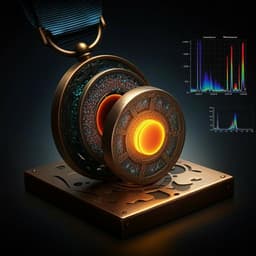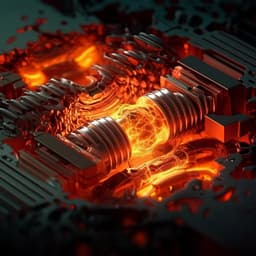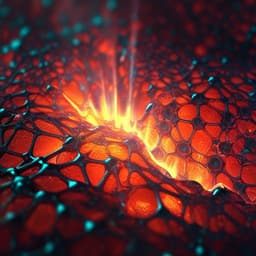
Physics
Rebuilding the vibrational wavepacket in TRAS using attosecond X-ray pulses
C. Wang, M. Gong, et al.
Explore the forefront of nuclear wavepacket dynamics! This study unveils how time-resolved resonant Auger-electron spectroscopy (TRAS) can capture the complete information of nuclear wavepackets using attosecond X-ray pulses. Conducted by a team of experts including Chao Wang and Victor Kimberg, this research opens exciting new avenues for understanding ultrafast phenomena.
Playback language: English
Introduction
Ultrafast electronic and nuclear dynamics are crucial in various chemical and physical processes. Time-resolved pump-probe experiments, utilizing techniques like time-resolved photoelectron spectroscopy and high-harmonic interferometry, have advanced our understanding of these dynamics. The advent of X-ray free-electron lasers (XFELs) has further revolutionized the field, enabling new pump-probe techniques such as time-resolved X-ray absorption spectroscopy and time-resolved X-ray photoelectron spectroscopy (TXPS). However, TXPS suffers from reduced energy resolution with shorter X-ray pulses. Resonant Auger-electron spectroscopy (RAS), achieved by resonantly tuning X-ray pulses to core-excited states undergoing Auger decay, mitigates this limitation. While RAS can recover vibrational structures, reconstructing the complete wavepacket remains a challenge. This paper addresses this challenge by theoretically demonstrating the full reconstruction of vibrational wavepackets from time-resolved RAS (TRAS) measurements using attosecond X-ray pulses. This approach is particularly important for studying coupled nuclear and electronic dynamics in complex systems at ultrashort timescales, offering an alternative and potentially superior approach to current ultrafast X-ray probing methods.
Literature Review
Numerous studies have explored ultrafast dynamics using various techniques. Time-resolved photoelectron spectroscopy has been used to distinguish vibronic molecular dynamics. High-harmonic interferometry allows tracking coupled vibrational and electronic dynamics. Attosecond transient absorption spectroscopy has enabled direct observation of non-adiabatic curve-crossing dynamics. The development of XFELs has expanded the possibilities further, with techniques like time-resolved X-ray absorption spectroscopy, time-resolved X-ray photoelectron spectroscopy, time-resolved X-ray photoelectron diffraction, ultrafast X-ray Raman spectroscopy, and ultrafast X-ray scattering being extensively applied. However, the use of attosecond pulses in TXPS encounters the problem of poor energy resolution, leading to difficulties in resolving vibrational structures. Previous work has demonstrated the advantages of RAS for preserving vibrational structures, however a complete reconstruction of the wavepacket remained a key challenge. This study builds on this previous work and existing methods for wavepacket reconstruction in other spectroscopic techniques, like attosecond transient absorption spectroscopy which has been used to reconstruct coherent electron motion and rotational wavepackets, and delay-dependent kinetic energy release which is able to resolve phase interference of ionic vibrational wavepackets. This work aims to advance the field by providing a method for fully reconstructing vibrational wavepackets from TRAS data using attosecond X-ray pulses.
Methodology
The researchers used a CO molecule as a model system. A nuclear wavepacket in the 5σ⁻¹π¹A'ᴵ state was generated by exciting the CO molecule from its ground state (X¹Σ⁺) using an 8.0 fs UV pulse. This wavepacket was then probed using a time-delayed (Δt) resonant attosecond X-ray pulse (τ = 1 fs and ω = 280.0 eV), initiating resonant Auger decay from the core-excited state Cls⁻¹π¹Πᴵ. The TRAS signal, corresponding to Auger decay to the 1π⁻¹²Πᴵ ionic state, was calculated using the quantum time-dependent wave-packet method, implemented in the Heidelberg MCTDH package. The potential energy curves and Auger width (Γ = 0.08 eV) were obtained from existing literature. Molecular rotation was neglected due to the short timescale of the experiment compared to the rotational period. The calculated TRAS spectra showed distinct 'revival' patterns as a function of the pump-probe delay (Δt), reflecting the coherent nuclear wavepacket motion. To reconstruct the initial wavepacket, the researchers developed a mathematical model to describe the time-dependent Auger electron spectra. This model expressed the Auger electron spectra as a function of energy (ε), pump-probe delay (Δt), and the initial vibrational states of the molecule. The model includes terms representing both incoherent and coherent contributions from different vibrational states. The relative populations and phases of the initial vibrational states were obtained by fitting the calculated TRAS signals to this mathematical model using the Levenberg-Marquardt and Universal Global Optimization algorithms within the 1stOpt software. The goodness of fit was evaluated using the coefficient of determination (R²). To assess the robustness of their method, the researchers also tested the reconstruction process with artificially blurred TRAS spectra, mimicking experimental uncertainties like energy resolution limitations and temporal jitters by introducing a random mask function to the TRAS data. They then repeated the fitting process using both three-state and four-state models, comparing the results to the original, unblurred data. Further simulations with even higher levels of instability (k = 10% and k = 20%) were performed to explore the limitations of the method under more challenging conditions.
Key Findings
The researchers successfully demonstrated that the full information of a coherent vibrational wavepacket can be reconstructed from TRAS measurements using attosecond X-ray pulses. Analysis of the TRAS signals revealed distinct 'revival' patterns with respect to the pump-probe delay, which reflected the oscillatory nuclear wavepacket motion. The fitting of the theoretical model to the TRAS data demonstrated that at least three, and possibly four, vibrational states were significantly involved in the initial wavepacket. The model accurately reproduced the time-dependent signal, achieving R² values close to 1.0. The fitting procedure yielded accurate values for the relative vibrational energies, populations (coefficients), and relative phases of the involved vibrational states, even when the initial wavepacket consisted of multiple vibrational states. Remarkably, the model accurately reconstructed the wavepacket even when significant random noise was introduced to simulate experimental imperfections. This was evident in the close agreement between the coefficients and phases obtained from both three-state and four-state model fits, even with blurred signals, highlighting the robustness of the method. The analysis of blurred TRAS spectra indicated that the method is resilient to moderate levels of noise, though the accuracy of phase retrieval is sensitive to both the fitting model and the noise level. Importantly, even when the Auger decay width was artificially increased to a value larger than the energy separation between vibrational levels, the method still provided meaningful reconstruction of the wavepacket. This suggests that this method can be applicable even when vibrational structures are not directly resolved in the TRAS spectra.
Discussion
This study presents a significant advancement in the field of ultrafast spectroscopy by demonstrating the feasibility of fully reconstructing vibrational wavepackets from TRAS measurements using attosecond X-ray pulses. The approach successfully recovers the key characteristics of the wavepacket: the relative energies, populations, and phases of its constituent vibrational states. The robustness of the method to noise suggests practical applicability. The method's ability to work even with broader Auger decay widths, surpassing the energy resolution limits of traditional techniques like TXPS, enhances its potential for studying complex systems with densely spaced vibrational levels. The findings pave the way for improved understanding of coupled nuclear and electronic dynamics in ultrafast processes, opening new avenues for investigating photochemical reactions and other dynamic events at attosecond timescales. The successful application of the reconstruction method to a diatomic molecule (CO) provides a proof-of-concept. Future work could explore the extension of the methodology to more complex polyatomic molecules, which will require careful consideration of the higher dimensionality of the problem and potentially more sophisticated modeling approaches.
Conclusion
This research successfully demonstrates a method to fully reconstruct coherent vibrational wavepacket dynamics from time-resolved resonant Auger-electron spectroscopy (TRAS) data using attosecond X-ray pulses. The method accurately retrieves the relative energies, populations, and phases of the vibrational states, even with substantial random noise. The study uses CO molecule as a model, and future investigations should explore the application of the method to polyatomic molecules and more complex systems. The robustness of the method, even with increased Auger decay widths, highlights its potential as a powerful technique in ultrafast X-ray spectroscopy. The method opens up new avenues for understanding coupled electronic and nuclear dynamics at attosecond time scales.
Limitations
The study focused on a diatomic molecule (CO) as a model system. Extending the methodology to polyatomic molecules will require accounting for the increased complexity of the vibrational modes and potential coupling between them. The robustness of the method to experimental noise was evaluated through the introduction of a random mask function; however, real-world experimental noise may exhibit different characteristics that could affect the accuracy of the reconstruction. The computational cost of the quantum time-dependent wave-packet calculations might limit the scalability of the approach to very large systems.
Related Publications
Explore these studies to deepen your understanding of the subject.







